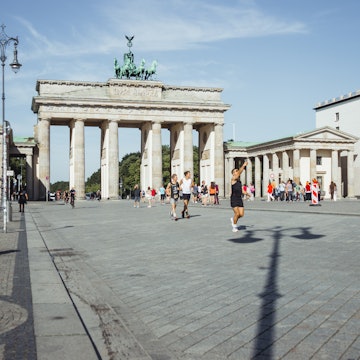
Get around in Germany with these top transportation options
May 4, 2024 • 4 min read

Germany's public transportation network is one of the best in the world (and kids under 15 travel on trains for free) © SbytovaMN / Getty Images
The birthplace of the Autobahn, Germany is a traveler’s dream. It boasts one of the most extensive, reliable and well-integrated transport networks in the world.
The roads here are well-designed and well-maintained, metropolitan public transportation is beautifully planned and efficient and the intercity train network is unsurpassed. Whatever means of transport you choose, you’ll find Germany easy to navigate.
While large by European standards, few parts of Germany are difficult to access. Cars are available to rent throughout the country, planes shrink larger distances (such as the 790km/490 miles between Munich and Hamburg) and car- and ride-share schemes are well established.
Here's what you need to know to find your way around in Germany.

Make the most of one of the world’s great train networks
Deutsche Bahn (DB), Germany’s national train operator, maintains a comprehensive, modern and reliable rail network. There are some private operators on the rails (like Ostdeutsche Eisenbahn in Saxony, Bayerische Oberlandbahn in Bavaria and the Hamburg-based Nordbahn Eisenbahngesellschaft) but all operate under the DB aegis.
Download the DB Navigator app before you arrive in the country and you’ll have access to ticketing, maps, timetables and everything else you need from the palm of your hand. If you’re planning on plenty of time on the tracks, DB’s rail passes are designed to allow visitors to take full advantage of the national network. Discounts are possible for two people traveling together on a twin pass and for 12–27-year olds, who qualify for youth passes.
Children up to age of 14 travel for free on German trains
Germany is a great place to take the family. It’s highly developed, clean and well organized. The welcome mat Deutsche Bahn (DB) rolls out for young rail passengers is exemplary: under-fives travel for free; kids aged five to fourteen travel free with a paying adult. There are designated family areas and surprises for kids on trains.

Drive on Germany's quality roads and Autobahn
Germany is a wonderful place for a driving tour. Visitors will find car-rental agencies everywhere at their convenience, all offering competitive rates on fleets of modern vehicles. Car sharing apps such as ShareNow are another excellent option, allowing you to prebook and collect a car, drive it for up to 30 days, and return it anywhere in its designated "home area". Petrol stations and EV charging stations are easily found – for the latter, simply use sites such as Chargemap and PlugShare.
Bus is a cheap alternative to the train
While it’s difficult to go past DB’s rail network, there are times when you might consider taking a bus (it is the cheaper option). In some areas, such as the Harz Mountains, sections of the Bavarian Forest and the Alpine foothills, it’s the only option.
Keen competition between companies keeps fares low and standards high. Buses are modern and comfortable, and usually offer on-board wifi, electrical outlets, toilets and drinks and snacks for longer journeys. FlixBus is the main German service, but RegioJet (Czech Republic) also operates in Germany.

Travel by bike on Germany's long-distance cycle trails
Many areas of Germany are extremely cycle-friendly, and it’s easy to hire good-quality touring bikes in most larger centers. If you have the fitness and inclination, definitely consider including a cycling tour into your itinerary. Rental sites like ListNRide and Cycle Europe allow you to pre-hire bikes from local outlets. Good-quality road bikes start from around €38 to €50 per day for hire. Helmets aren’t mandated by law but are always a good idea.
A network of more than 200 well-marked long-distance cycle trail fans out across Germany. Some of the stand-out routes include: the Altmühltal Radweg, which runs for 167km (104 miles) beside the river Altmühlt in Bavaria’s Altmühltal Nature Park; the Elberadweg, following the Elbe 1300km (808 miles) from its source near Dresden to its estuary near Hamburg; and the Donau Radweg, following the Danube for 434km (270 miles) between Passau and Neu-Ulm.

Ferries and boats are a lovely way to travel the coast, rivers and lakes
While Germany has only two sea borders, it has plenty of lakes, and there’s a chance you’ll need to travel over water at some point. The Baltic islands off Mecklenburg–Western Pomerania, the East Frisian Islands in Lower Saxony and the North Frisian Islands in Schleswig-Holstein all require ferries for access.
Scheduled boat services plying the Rhine, the Elbe and the Danube can be a delightful way to travel along these rivers. The same applied to large lakes like Chiemsee and Lake Starnberg in Bavaria and Lake Constance in Baden-Württemberg.
Germany has good accessible transportation
Germany is a rich, civic-minded country with generally excellent provisions for the mobility impaired. Organizations such as the Association for Barrier-Free Destinations in Germany, Deutsche Bahn and the German National Tourist Board are serious about reducing obstacles to accessibility and compiling resources for visitors.















